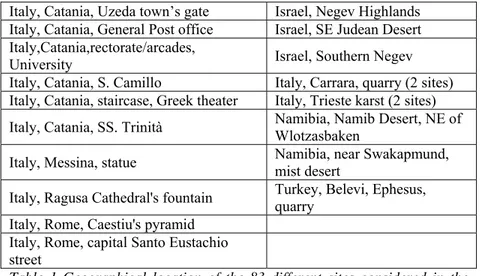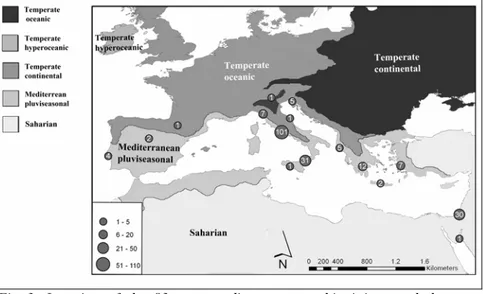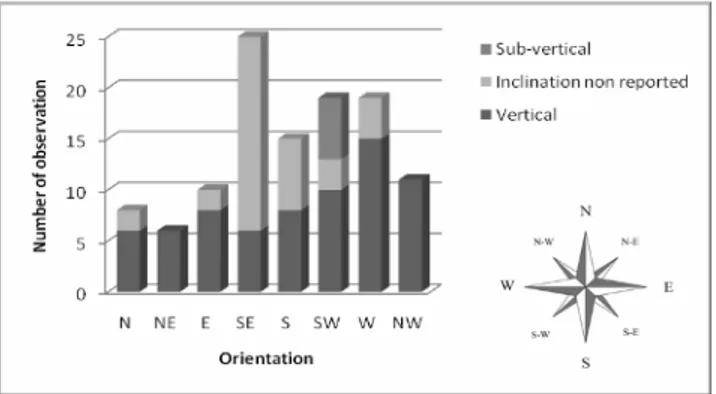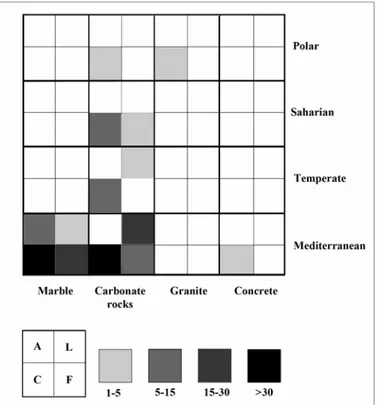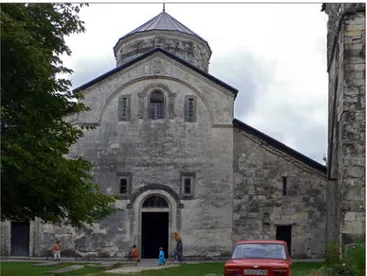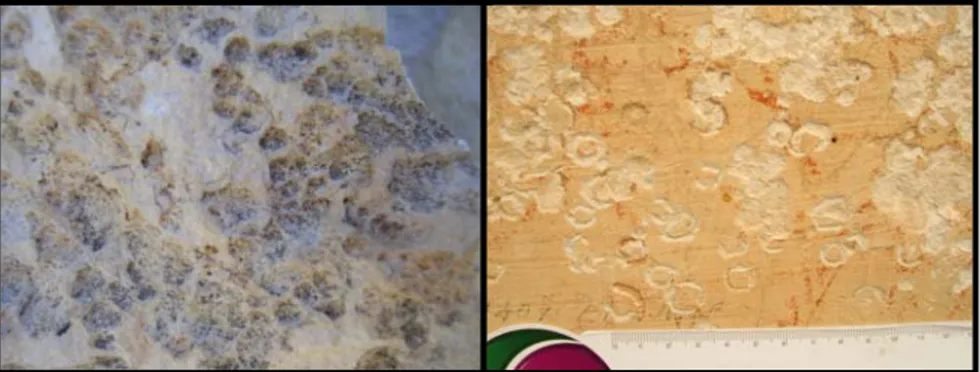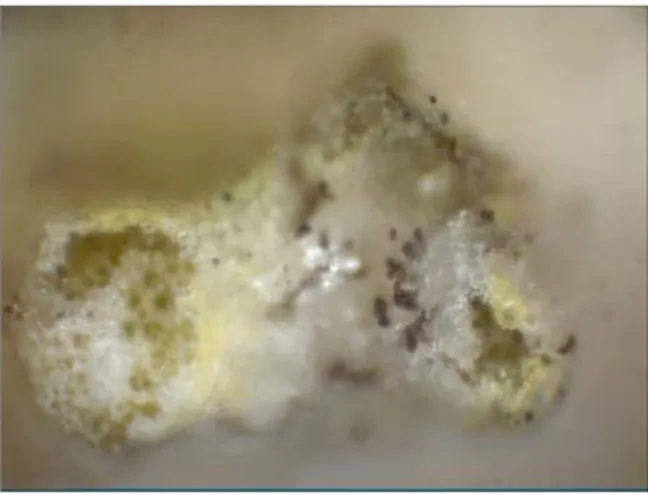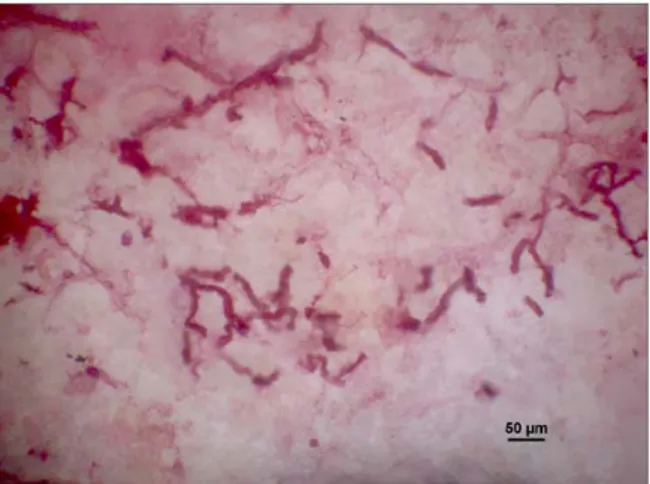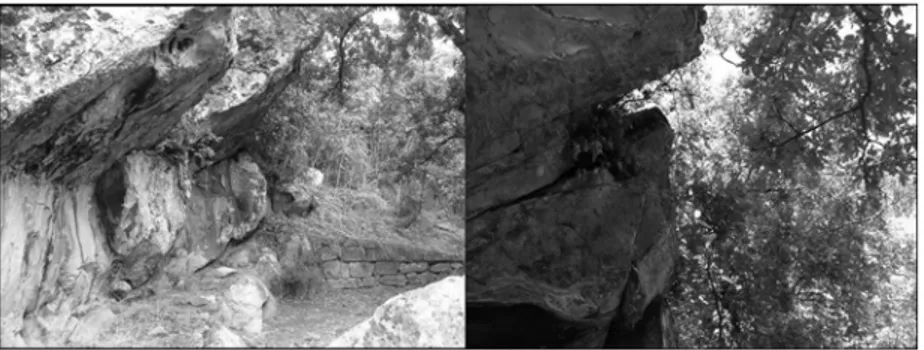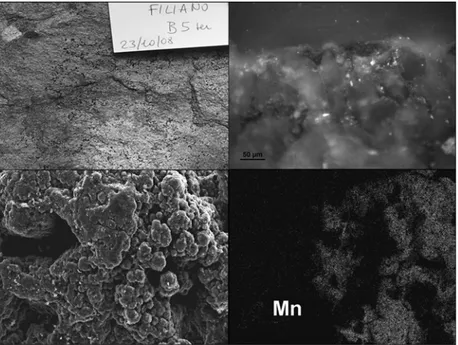DOCTORAL SCHOOL IN BIOLOGY Section: Biodiversity and Ecosystem Analysis
XXIII CYCLE
Erosion of carbonatic lithotypes by endolithic organisms under terrestrial conditions: ecological aspects and biodeterioration
problems
Erosione di litotipi carbonatici ad opera di organismi endolitici in condizioni subaeree: aspetti ecologici e problematiche di biodeterioramento
Valeria Lombardozzi
A.A 2011/2012
Tutor: Prof. Giulia Caneva
Lombardozzi V., 2008. Erosion of carbonatic lithotypes by endolithic organisms under terrestrial conditions: ecological aspects and
biodeterioration problems. Doctoral thesis. Department of Environmental Biology, Roma Tre University, Rome, Italy.
Valeria Lombardozzi
Department of Environmental Biology, Roma Tre University, 446 Viale Marconi, 00146 Rome, Italy.
E-mail: [email protected], [email protected] © Valeria Lombardozzi
No parts of this thesis, including papers that are submitted, must be reproduced without permission.
Front cover: pitting deterioration of a natural rock (Photo by V.Lombardozzi).
Thesis defense on the 15th December 2011 in front of the following jury: Aldo Musacchio (National evaluator)
Paolo Audisio (National evaluator) Nadia Abdelahad (National evaluator)
Table of contents
1. Introduction... 1
2. Interactive bibliographic database... 7
3. Characterization of euendolithic organisms and weathering processes... 28
3.1. Sample sites selection... 28
3.1.a Church of the Virgin in Martvili, Georgia 3.1.b Hebrew’s cemetery tombstones, Venice, Italy 3.1.c Carrara’s Quarry, Massa-Carrara, Italy 3.1.d Archaeological sites of Rome 3.1.e Calcareous cliffs of the Amalfi Coast, Italy 3.1.f The prehistoric site of Filiano (Basilicata, Italy ) 3.1.g Negev desert, Israel 3.2. Samples collection... 30
3.3. Samples analysis... 31
3.3.a Petrographic analysis 3.3.b Samples polyphasic cyanobacterial characterization 3.3.c Samples morphological analyses 3.3.c.1 Church of the Virgin in Martvili, Georgia 3.3.c.2 Hebrew’s cemetery tombstones, Venice, Italy 3.3.c.3 Carrara’s Quarry, Massa-Carrara, Italy 3.3.c.4 Archaeological sites of Rome 3.3.c.5 Calcareous cliffs of the Amalfi Coast, Italy 3.3.c.6Negev desert, Israel 4. Cases of study... 54
4.1. The erosion of the carbonatic external walls of the “Church of the Virgin” in Martvili (Samegrelo Region, Republic of Georgia) by endolithic organisms: preliminary results... 54
4.2. Bioderioration problems of mural paintings in rock habitat: the prehistoric site of Filiano (Basilicata, Italy)... 66
5. General Conclusions... 75
6. Bibliography... 77
PREFACE
This thesis is based on three papers, two published and one submitted to peer-reviewed journals. In the common introduction were briefly addressed the issues related to biodeterioration phenomena, to the peculiar characteristics of endolithic organisms and the overall aims of the thesis. Chapter 2 and chapter 4 correspond to papers in particular:
CHAPTER 2: Lombardozzi V., Castrignanò T., D’Antonio M., Casanova Municchia A., Caneva G. An interactive database for an ecological analysis of stone biopitting. Submitted
.CHAPTER 4:
Caneva G., Lombardozzi V., 2011 – The Erosion of the carbonatic external walls of the “Church of the Virgin” in Martvili (Samegrelo Region, Republic of Georgia) by endolithic organisms. Proceedings of the 2nd Symposium of Georgian Arts and Culture “Georgia on the Crossroads. Cultural Exchange across the Europe and Beyond”, Florence November 2-9, 2009
.
Caneva G., Nugari M.P., Pietrini A.M., Salvadori O., Tufano M., Lombardozzi V., 2010 - Biodeterioration problems of mural paintings in rock habitat: the prehistoric site of Filiano (Basilicata, Italy). Proceedings of the 4th International Congress on “Science and Technology for the Safeguard of Cultural Heritage in the Mediterranean Basin” (A.Ferrari, E. Sirugo, S. Tardiola, eds), Cairo (Egypt) 6th-8th December 2009.
Chapter 3 deals with the samplings collection and analyses of this reseach project, and with the problematics which have arised in this study.
In the final section, the outcomings of the papers and of the analyses in chapter 3 were utilized for drawing conclusions on the status of knowledge on pitting and the organisms related and for discussing further steps to be undertaken in order to make more efficient the protection of Cultural Heritage from biodeterioration.
CHAPTER 1
Introduction
In the last decades the growing concern for the preservation of Cultural Heritage monuments has led to the understanding that the role of biological matter in their degradation processes, has not to be neglected. Most investigations have stressed the importance of phototrophs in the physical and chemical deterioration of stones. In the Conservation of Cultural Heritage this is called biodeterioration, that is “any undesiderable change in the properties of a material caused by the vital activities of organisms”. (Hueck, 1965, 1968). The role of these organisms in the deterioration of surfaces of historic buildings has been the subject of several studies but it appear to be not perfectly clear. Their activity in weathering of rocks is considered to occur by means of chemical and physical processes, often deeply connected between them. In many cases, microorganisms are considered one of the main causes of stone deterioration (Warscheid & Braams, 2000). Epilithic and endolithic organisms can potentially contribute to the breakdown of rock crystalline structures. Some investigations in the past decades have suggested that many physical, chemical and biological factors act in both synergistic and antagonistic associations to effect durability of the material (Crispim & Gaylarde, 2005).
Depending on the environmental conditions, bacterial polysaccharides may precipitate calcium carbonate, while some acids may react with calcium from stone to form other minerals. Similarly, oxalic acids can form calcium oxalate on limestone. Solubilization processes, including acidolysis, complexolysis, alkalinolysis corresponding to the formation of acidic, complexing and alkaline metabolic compounds, have been reported (Chen et al., 2000).
Several studies suggest that the chemical processes induced on the stone material by microorganisms are represented by the excretion of corrosive acids especially on limestone and marble, while other studies put forward the hypotesis that precipitation of calcium salts on cyanobacterial cells growing on limestone could favour the migration of calcium from neighbouring sites. Precipitation of poorly ordered iron oxides and amorphous alumino-silica gels, the neoformation of crystalline metal oxalates and secondary clay minarals have been freqeuntly identified in a variety of rocks colonized by lichens (Chen et al., 2000). Some cyanobacteria pose an external layer that binds calcium ions producing local high level of pH and it has been suggested that this repeated mobilization by
organisms’ cells could lead to degradation of calcareous stone. Moreover also biofilms EPS (extracellular polysaccharide substances) have been observed to increase dissolution rate of calcium carbonate, suggesting that they also may contribute to deteriorating the stone.
In the case of chasmoendolithic cyanobacteria it has been suggested that the contribution to the decay of calcareous stones consists in the exertion pressure from within the stone as a result of water uptake, expansion of cell mass and precipitation of carbonates and oxalates around the cells. The results is the opening of fissures which allow the entry of dust, pollen, grains and small animals and furthermore, the increasing internal pressure on the superficial layer of the structure that may lead to its detachment. (Danin & Caneva, 1990; McNamara & Mitchell, 2005).
Taking a good look it appears clearly that almost all natural carbonate rock surfaces, as well as carbonate building stones are, in various ways, colonized by micro-organisms (Pohl et al., 2002). Depending on the way in which these organisms occupy rock surfaces, distinction should be made between epiliths, which live on the surface of the substrate, and endoliths which dwell within the substrate itself. Endolithic organisms, moreover can be divided depending on the way they colonize the inside of the stone in (1) chasmoliths, which adhere to the surfaces of pre-existing fissures and cracks; (2) criptoendoliths, which colonize structural cavities within porous rocks, and (3) euendoliths which actively penetrates into carbonates substrates (Golubic et al., 1975) (fig.1).
Fig.1 Description of endolithic organisms. (Golubic et al., 1975, modified). The density of colonization may vary as well as the maximum penetration depth and biomass per unit area. Even on surfaces which are strongly marked by chemical corrosion, euendolithic microorganisms have been reported to actively create small cavities where they survive despite the most estreme and adverse conditions. Accordin to Pohl et al. 2002, ‘bare rock’ as described frequently in literature, should, at least where carbonate rocks are concerned, be considered rare exception.
Endolithic colonization develops beneath the rock surface and gives rise to complex communities depending on environmental conditions and physico-chemical properties of the material.
The existence of microbial population that dwell on and inside hard mineral substrates, primarily carbonates and phosphates, has been noticed since the 19th century, but the early reports were not clear in distinguish between phototrophic and heterotrophic microboring organisms (Golubic et al., 1975).
Endoliths appear to colonize the spaces beneath rock surface which has not been colonized by epilithic communities. It has also suggested that escape into endolithic environment is driven not by hostile surface conditions, but by the decreased competions for nutrines and space. Among the lithophytes,
organisms native to the endolithic environment are generally described to be slow-growing, adaptive and tolerant to severe stresses including extreme temperatures, disseccation, oligotrophy and high UV flux (Sigler et al., 2003; Salvadori, 2000).
In the case of photosynthetic microborers they are limited in their extent mainly by the depth of light penetration in the specific substratum where they are found, so that the characteristics of the carbonate rock, physical and chemical, are important factors in favouring or not their development. Cyanobacteria (blue-green algae) are considered as one of the most important group as pioneer organisms of rock surfaces. Together with them are mostly found eucaryotic algae, fungi and lichens.
Pitting is considered one of the most important deterioration process for what concerns natural and building calcareous rocks under terrestrial conditions and it is characterized by the formation, on the substrate, of pits and holes of variable depth and diamenter. The processes that causes pitting still appear to be controversial. Several factors seem to influence the weathering rate of the substrate by inducing the formation of pits. These, beside the petrographic and physico-chemical parameters which can create differential localized effects, include the morphology and micromorphology of the surface but also the inclination and exposure of the surface and finally the eventual action of stone-carving tools. However a larger consesus has recenlty gained the idea that pitting could be associated with microorganisms activity. Infact, often it is possible to observe that pits are colonized by microbial populations. According to Danin, the respiration processes of an organisms that estabilish itself among rock crystals, accellerates the weathering rate of the substrate near such organisms. This depends on the realease of CO2 to the water when the rock is wetted, forming the weak acid, carbonic acid (H2CO3) which dissolves the rock parts that are in direct contact with the organism. Thus, the coherence of particles to the rest of the rock decreases, and their erodibility by splashing raindrops increases. This, due to the faster weathering processes here than that of the entire surface, would explain the formation of depression in the rock which, otherwise, exposed only to enviromental agents, should be expected to weather at about the same rate all over the surface. In such pits, infact, the transition from the area populated with the supposed pit-inducing organism to the area not populated with it is sharp and the pit walls are steep.
Gehrmann et al., 1992, give a classification of pitting defining micro-, meso- and macropitting:
- Micropits are microscopic holes detectable only via microscopy with diameter on average from 0.5 to 20 µm produced by bacteria and microscopic fungi as single organisms. These pits can join together forming larger micro-pits;
- Mesopits are circular or oval pocket-like impressions in the stone surface, with size that ranges between 20-1000 µm on average and diameter 4-5 times bigger than the depth of ther crater. These appear to be linked with etchings of the fruiting bodies of endolithic lichens as well as of their phycobionts;
- Macropits are deterioration forms with a diameter on average from 1mm to 2cm, and as well as mesopits show a diameter 4-5 times bigger than the depth of ther crater. Their origins hasn’t been explained clearly.
However, these definition are far more distant than be considered more than preliminary and as a first step towards a classification of biogenically and abiogenically formed surface changes in building materials. And moreover it is still yet to demonstrate clearly whether the organisms which are found inside the pits actively contribute to their formation or simply they have found in them a more favourable ecological condition. (Caneva et al., 1992; Chacon et al., 2006).
Since their first description endolithic organisms have been observed in a variety of extreme ecosystems including warm and cold deserts and Polar regions. They have been detected also in temperate environments such as the Niagara Escarpment, Canada and in a variety of rock types (Sigler et al., 2003).
Many studies have been performed on endolithic microflora in coastal environment while even though the occurrence of phototrophic microorganisms on stone monuments has been recognised frequently, only few authors have reported the presence of endolithic photosynthetic microorganisms on monuments and often only in general ways not investigating the relationships between the organisms and the nature of the substrate or the ecological environmental conditions.
Besides the number of investigations due to the growing interest in preserving stone monuments from biodeterioration, what is still missing is a comprehensive picture of the knowledge achieved up to now on this subject in order to make possible trying to draw general rules on environmental conditions and mechanisms of colonization.
In fact, it is only through a clear understanding of the detailed endolithic communities structure and composition, of the ecological conditions in the various microhabitats and of the detailed mechanisms and rates of stone
decay, that protection from biodeterioration could become more efficient, preventing more than curing the damages.
The aims of this research project have been than to:
- Understand the state of the knowledge on biodeterioration phenomena, up to now;
- Understand the macro- and microclimatic parameters which favour their estabilishment;
- Characterize euendolithic colonization through polyphasic approach;
CHAPTER 2 – AN INTERACTIVE DATABASE FOR AN
ECOLOGICAL ANALYSIS OF STONE BIOPITTING
CHAPTER 2
An interactive database for an ecological analysis of stone
biopitting
Lombardozzi V*, Castrignanò T.**, D’Antonio M.**, Casanova Municchia A.*, Caneva G.*°
* Dep. Env. Biology, University Roma Tre, viale Marconi 446, Roma **Via dei Tizi 6, Roma
° Corresponding Author Abstract
The literature on stone pitting due to biodeterioration is wide, but the diffusion of this phenomenon and the taxonomy of the organisms supporting it in the different environmental and edaphic conditions are questions not sufficiently described. Therefore an interactive on line database has been built up from the literature concerning the pitting of stone under terrestrial conditions, in order to synthesize the available information and to give a critical view on bibliographic data. Among the about 800 papers selected in the first step, only 24 reported parallel information on the object, the affected material, and the organisms associated to the pitting, necessary to be included in the data bank. These first data are concerning 83 different sites, for a total of 249 samplings, mainly coming from the Mediterranean bioclimatic area, even though the phenomenon is not exclusive to this climate. The most recurrent etiological agents are cyanobacteria, and the associated environmental conditions are dryness, arising from the low porosity of the stone, exposure conditions and from the bioclimate. These factors explain the so high recurrence of marble, the preference for vertical or subvertical surfaces and the high recurrence of Mediterranean and desert climate. The lack of information describing the phenomenon in the whole (stone/exposition/biodeteriogens) has not permitted to use the full potentiality of the interactive data base.
Keywords: stone biodeterioration, pitting, endolithic organisms, cyanobacteria, data base
1.Introduction
Rocks as well as stone buildings materials can be more or less easily colonized by different microorganisms and plants in relation to their characteristics, the surrounding environmental conditions, and the time of outdoor exposition (Ortega-Calvo et al., 1995; Warsheid & Brahms, 2000; Pohl & Schneider, 2002; Caneva et al,, 2009).
Weathering due to biological agents is however often underestimated when the growth of microorganisms does not form typical coloured patinas and incrustations and it is frequently misunderstood with chemical and physical phenomena. In fact, organisms can colonise and grow on the upper surface of the stone (epilithic) or inside fissures already existing or newly formed by themselves (endolithic), giving rise to exfoliation or pitting phenomena, consisting in the formation of blind holes close together and generally of cylindrical shape (Golubic et al., 1980; Danin, 1992b) (Fig. 1).
The process that causes pitting of stone is controversial due to the difficulty to determine whether the organisms which are found inside the pits have actively contributed to their formation or simply they have found in them more favourable ecological conditions (Salvadori, 2000; Caneva et al., 1992).
Whether of biological or abiological origins, pitting causes damages to the stone material that, concerning stone monuments of cultural heritage, could prove to be quite remarkable. Due to this fact, the attention on pitting phenomena and the possible organisms linked to them has increased and consequently several studies concerning its origins, the physiology and ecology of the organisms found inside the pits have been carried out. Prior to the advent of the internet, biological databases and scientific publications were absolutely separate entities. However, now that scientists use cyberinfrastructure in their daily research, databases and publications continue to be so distinct from each other. There are myriad ways in which the content of an article can be used in a computational manner and the technology and infrastructure to make this happen already exists; this is demonstrated by, among other things, the existence of biological databases and related data mining tools. Indeed, a successful biological database is integration via data mining with other related databases or resources. Yet integration with literature, which is unquestionably the primary medium through which scientists communicate their research, is conspicuously lacking.
Databases help in collecting and analyzing the available data in literature, even if problems arising from the absence of standards on methods of
analysis, and the different aims of the various papers often creates difficulties in elaborating data (Caneva et al., 1985).
An interactive online database has been already developed for two main purposes:
1) Synthesizing the available information in literature on stone pitting phenomena
2) Giving a critical view on bibliographic data. In particular we wish to find recurrent frequencies of these phenomena, evaluating: a) which are the most favouring environmental conditions, b) which is the most affected kind of stone, c) which are the most common biodeteriogens and d) which are the most significant recurrence among the interacting factors.
a
b
Fig.1 a) Detail of SE exposure (drum XI), (replicas of 1862) b) Different morphology of pits of the Trajan’s column
2.Materials and Methods
The design and the development of Biopitting data-base has been based upon a critical survey of the existing literature. In particular, we selected papers responding to the following three requirements: a precise description of the object under examination (both stone monuments or stones in natural sites); the description of the stone affected by this phenomenon and the report of pitting biodeterioration phenomena found and analysed. We also limited, at this moment, the selection to the euendolithic organisms of terrestrial habitat, because they are the most interesting in the biodeterioration of monuments, as described in the literature.
In parallel, we selected the descriptors of the database in order to give a better ecological, biological and technical description of the pitting phenomena and the organisms related: firstly the bibliographical references, then the information about the object, considered as “sampling site” (including constitutive material, geographical location, phisical and environmental parameters). Then we considered the descriptors of each sampling reported, such as the sampling techniques used and the season in which it has been collected, the morphology of the biodeterioration phenomenon (the diameter, depth, shape and chromatic variations of the pits), the rate of weathering and chemical and biochemical analysis applied to it. Finally we searched for taxonomical and physio-ecological information (the type and species of organisms found in the pits, if they are endolithic and are still alive or not and any information about cultural techniques applied) (Fig. 2).
Fig.2 Structure of the database (http://mi.caspur.it/biopitting/biop_home.php)
For every paper selected to be uploaded in the database, it was provided a window in which are reported samples’ and samplings’ descriptors, which would have been taken by reading accurately each paper.
After filling in the database the chosed papers, we compared some parameters between each other and pointed out some observation concernig their relations, using the possibility given by the database itself to perform queries and download the results in excel tables. Due to the heterogeneity of the information in the database, in order to make some general considerations, we grouped in wider ensembles some of the information reported in it, in particular those about the substrate and the type of organisms. For what concernes the lithotypes we grouped into 4 groups the 18 lithological tipologies that we found in the literature. These are: carbonate rock (which gather together calcitic rock, calcareous litheranite, hard, Lioz and Turonian limestone, Verona red stone and Istrian stone,
calcarenite, massive biocalcarenite and dolomia), marble (which includes pentelic and Carrara marbles), granite and concrete.
Moreover we normalize the highly different ways of referring to the organisms found in the pits into only four taxonomic major groups, which are Cyanobacteria, Algae, Lichens and Fungi.
The information concerning the descriptor “Bioclimatic Region”, important under the ecological point of view, have been introduced by us, considering the location of the investigated site.
Biopitting (interactively accessible at http://www.caspur.it/biopitting/) is a relational database available through a dedicated web interface. The database is implemented on a SUSE Linux Enterprise Server (SLES 10) running MySQL 5.1 enterprise. The web interface (written in PHP) runs on a Scientific Linux Server (version 6.1) through Apache server.
3.Results
Among almost 800 papers searched dealing with stone biodeterioration, only 24 have proved to match the three characteristics that we thought of in building this biopitting database. The sum of the investigated sites is however not negligible and data deals with 83 different sites, for a total of 111 sampling zones (i.e. the part of the sampling site were samples have been collected) and a total number of 249 samplings. Among the sampling site, 57 are monuments and 26 are natural sites, as described in Table 1. Many information were however only scarcely reported, such as stationary parameters, (exposures, inclination), or precise geographical indications such as latitude, longitude, altitude, and climatic data (pluviometric rate and minimal and maximal temperature). When different samplings were described, the information on each sampling seemed to be often incomplete and less detailed. Information about the methodology, techniques and sampling season and also about the sampling zone is scarcely reported. Moreover, information concerning the use of biocides, type, employment method, treatment period and collateral effects, have never been found. Monuments Italy, Rome, Forum Traianum Greece, Athens,Dyonysos Theatre Italy, Rome, Forum Traianum, statue Greece, Corfù, obelisque Italy, Rome, Pasquino's statue Israel, Jerusalem, Bet Hakerem Italy, Rome, St. Stephen Basilica Israel, Jerusalem, el-Kebkebi Mausoleum Italy, Rome, Trajan's column Israel, Jerusalem, Emir Adughdi el Italy, Trento, Neptune fountain
Kubaki
Israel, Jerusalem, house's walls (2 sites) Italy, Venice, Ducal Palace Israel, Jerusalem, Moslem cemetery (3
sites)
Italy, Sanctuary of Macereto, Visso (Macerata)
Israel, Jerusalem, walls of the old city (2
sites) Portugal, Lisbon, Jeronimos Monastery Israel, Maale Efrayim Portugal, Lisbon, tower of Belem Israel, Qidron Valley, Grave of
Pharaoah's Daughter Spain, Jaca, Roman Cathedral Israel, Qidron Valley, Zacharia's grave Spain, Segovia, Convent of Santa Cruz la Real Israel, Sede Boqer, northern Negev
Highlands Turkey, Didim, Temple of Apollo Israel, Tomb of Pharaoh's Daughter Natural sites
Italy, Agrigento, Concordia Temple Antarctica, McMurdo valley, Commonwealth Glacier Italy, Catania, balaustrade, S. Francesco
d'Assisi Antarctica, McMurdo valley, Goldman Glacier Italy, Catania, rail’s arches, Pacini Villa Antarctica, McMurdo valley, Mont Falconer Italy, Catania, Bianchi’s Confraternity Australia, Naumburg Nat. Park, Pinnacles desert Italy, Catania, Archbishopric Egypt, desert of Sinai
Italy, Catania, colonnade, Mazzini
Square Greece, Crete cliffs
Italy, Catania, Fac Liberal-arts Faculty/
Unversity Greece, Crete, wetter areas Italy, Catania, fountain “the kidnapping
of Proserpina” Hungary, Bukk Mnt
Italy, Catania, fountain, Botanical garden Israel, Jerusalem, desert Italy, Catania, main facade, S. Placido Israel, Jerusalem, hilltop Italy, Catania, Benedectines Monastery Israel, Jerusalem, near Hebrew University Italy, Catania, stock market Palace Israel, Jordan Valley N of Jericho Italy, Catania, porch, De Felice Inst Israel, Lake Kinneret Italy, Catania, Garibaldi town’s gate Israel, Mediterranean Israel cliffs
Italy, Catania, Uzeda town’s gate Israel, Negev Highlands Italy, Catania, General Post office Israel, SE Judean Desert Italy,Catania,rectorate/arcades,
University Israel, Southern Negev
Italy, Catania, S. Camillo Italy, Carrara, quarry (2 sites) Italy, Catania, staircase, Greek theater Italy, Trieste karst (2 sites) Italy, Catania, SS. Trinità Namibia, Namib Desert, NE of Wlotzasbaken Italy, Messina, statue Namibia, near Swakapmund, mist desert Italy, Ragusa Cathedral's fountain Turkey, Belevi, Ephesus, quarry Italy, Rome, Caestiu's pyramid
Italy, Rome, capital Santo Eustachio street
Table 1 Geographical location of the 83 different sites considered in the biopitting database
Most of the sampling sites described in the literature come from the Mediterranean Basin and are distributed in 10 countries for a total of 47 geographical localities (i.e, municipalities).
In particular, 67 sites are included in the bioclimatic Mediterranean region (87% of samples) while only 7 in the Saharian one (4 %), 6 in the Temperate zone of Eurasia (5,4%), and 3 in the Polar one (2%).
Fig 3. Location of the 83 case studies on stone biopitting used data, corresponding to 47 municipalities (14 in Italy, 18 in Israel, 4 in Greece, 2 in Namibia, Turkey, Spain and Portugal, 1 Australia, Antarctica and Egypt) (Worldwide Bioclimatic Classification System, 1996-2009, S.Rivas-Martinez & S.Rivas-Saenz, Phytosociological Research Center, Spain. http://www.globalbioclimatics.org)
Looking at the selected case studies and precisely in those where data on inclination of the surfaces were reported, the phenomenon was mainly described for vertical ad subvertical surfaces showing a certain preference for the Southern expositions (Fig. 4).
Fig 4. Expositions of the sampling sites
Moreover, according to the information collected in the database, the stone that is reported to be more frequently in association with this kind of stone deterioration, is marble, counting to the 53% of the total number of samplings, followed by carbonate rock with 44%. The remaining 3% is referred to granite and concrete (Fig.5a).
a) b)
c)
Fig.5 a) Type of substrates affected; b) Frequency of the organisms detected c) Frequency of the organisms on the different substrates
According to the papers uploaded in the database, cyanobacteria, with 50%, are the most commonly described biodeteriogens found in association with pitting, followed by fungi, lichens (respectively 11% and 10%) and algae with 5%. The remaining 23% of the total number of samplings refers to some case of studies in which no precise indication of the type of organisms found in the pits sampled is reported (Fig. 5b).
Looking at the organisms in relation to different kind of stone, on carbonate rocks we found also the most evident recurrence of cyanobacteria (27%) such as for marble, but in lower amount (22 %), probably due the highest number of not reported identification. Lichens in particular are most frequently mentioned on carbonate rocks than on other material (Fig. 5c). The species collected from pittings, considering the relative numbers of citations and the papers dealing with them, are listed in Table 2. It shows again that cyanobacteria have the highest biodiversity of collected taxa, and many species are mentioned as endolithic (e.g. Hyella and Lichenotelia), but in other cases, especially when only the genus is detected, it is difficult to interprete if they were epi- or endo-lithic.
Cyanobacteria n° Tot presence n° papers n° sampling sites Aphanocapsa muscicola (Meneghini) Wille 1 1 1
Aphanocapsa roeseana de Bary 3 1 2
Calothrix marchica Lemmermann 1 1 1
Calothrix marchica Lemmermann
var. crassa Rao 3 1 1
Chroococcus minor (Kutz) Nageli 1 1 1
Chroococcidiopsis sp. 1 1 1
Clastidium setigerum Kirchner 1 1 1
Cyanothece sp. 1 1 1
Dalmatella sp. 1 1 1
Entophysalis deusta (Meneghini)
Drouet et Daily 4 1 3
Entophysalis rivularis (Kutzing)
Drouet 21 1 20
Entophysalis sp. 1 1 1
Gloecapsa biformis Ercegovic 3 1 2
Gleocapsa calcarea Tilden 2 1 2
Gleocapsa sp. 2 2 2
Gloeothece rupestris (Lyngbye)
Bornet in Wittrock et Nordstedt 1 1 1
Hyella sp. 1 1 1
Lyngbya aff. limnetica 1 1 1
Microcoleus chthonoplastes
Thuret ex Gomont 1 1 1
Microcystis sp. 3 1 2
Myxosarcina sp. 1 1 1
Myxosarcina spectabilis Geitler 3 1 1
Myxosarcina concinna Printz 9 1 2
Phormidium foveolarum Gomont 6 1 2
Plectonema radiosum
(Schiederm.) Gomont 2 1 2
Plectonema sp. 1 1 1
Pseudocapsa dubia Ercegovic 1 1 1
Pseudocapsa sp. 1 1 1
Schizothrix sp. 1 1 1
Stigonema muscicola Borzì ex
Bornet et Flahault 1 1 1
Synechococcus sp. 4 1 2
Synechocystis sp. 2 2 2
Symploca dubia Gomont ex
Gomont 1 1 1
Tolypothrix byssoidea (Berk.) 2 1 1
Fungi
n° Tot
presence papers n° n° sampling sites
Cladosporium sp. 1 1 1
Diplodia sp. 1 1 1
Lichenothelia intertexta Henssen 1 1 1
Lichenothelia globosa 1 1 1 Lichenotelia sp. 3 2 3 Ochroconis sp. 1 1 1 Phoma sp. 3 1 3 Trichoderma sp. 1 1 1 Ulocladium sp. 3 2 3 Coniothyrium sp. 1 1 1 Alternaria sp. 1 1 1 Hormonema sp. 1 1 1 no spp 13 5 Lichens n° Tot
presence papers n° n° sampling sites Buellia peregrina Bungartz &
V.Wirth 1 1 1
Caloplaca alociza (A. Massal.)
Mig. 5 2 2
Caloplaca sp. 1 1 1
Encephalographa elisae A.
Massal 1 1 1
Petractis clausa (Hoffm.) Kremp. 1 1 1
Verrucaria baldensis A. Massal 1 1 1
Algae
n° Tot
presence papers n° n° sampling sites
Chlorococcum sp.1 3 1 2 Chlorococcum sp.2 4 1 2 Haematococcus pluvialis Flotow 1 1 1 Heterococcus caespitusus Vischer 1 1 1 Stichococcus bacillaris Nageli 1 1 1 Ulothrix sp. 1 1 no spp 3 2 1
Tab 2 List of the species cited in the literature
Looking at the recurrence among the factors, we can observe once again the highest recurrence of the binomial (Mediterranean/cyanobacteria) and of carbonate and marble stones (Fig. 6). In particular we can also note that data on marble come only from the Mediterranean climate, and we have no other data on this material in other climatic context. In the case of carbonate rocks we have the highest wideness of recurrence in the different climatic contexts, but in all the conditions cyanobacteria are the most recurrent group. Lichens show in any case a not negligible recurrence.
In order to have stronger data we need to improve the information, considering case of studies coming from wider contexts.
Fig 7 Distribution of the organisms detected, on different substrata in each bioclimate. The gray scale indicates the frequency of the organisms C=Cyanobacteria; A= Algae; L=Lichens; F=Fungi
White boxes indicate the absence of organisms 4. Discussion
4.1 Environmental conditions & stone biopitting
The predominance of the bioclimatic Mediterranean region in the selected samples probably does not reflect the real distribution of the phenomenon, because in the most general literature, that we excluded for the database due to the absence of the necessary requirements, many other localities are listed. As for example we can mention the diffusion of the phenomenon on the Dalmatian coasts (one of the first place of description due to Golubic et al., 1975) or also in different Italian calcareous cliffs. Moreover the phenomenon is observed on exposed rocks both in cold and in hot deserts,
as referred by many Authors. We also observed biopitting phenomena in temperate climate on limestone of the walls of a Georgian church near the Black sea (Caneva et al. in press) and N Europe, such as in Dresden (Germany). Even in tropical countries, such as Mayan calcareous monuments in Mesoamerica, stones colonized by endolithic cyanobacteria are sometimes detected. In those papers where the ecological conditions which favour this phenomenon are discussed, a certain climatic or edaphic xericity seems to be recurrent, as a common factor characterising the phenomenon.
The data of exposition and inclination of the surfaces suffering biopitting seems to stress a certain linkage of this phenomenon with conditions of dryness, because obviously as much the surface is vertical as less easily water is retained. Moreover southern exposition are more subjected to exsiccation, even if in case of Rome, vertical surfaces with this exposition are the only ones that receive water by the incident rainfall (Caneva et al., 1992), constituting in any case an extreme condition of xericity.
4.2 Stone & pitting
Marble is often described as the most affected material, but also calcareous rocks can be greatly weathered by this phenomenon. Looking at the literature in general, we need however to observe that a precise classification of stone type is one aspect in which a gap of knowledge exists in the studies on biodetetioration even if it is, on the contrary, an important passage to understand how the susceptible different types of stone react in different environmental conditions.
4.3 Pitting & organisms
Cyanobacteria are the dominant group associated with pitting, but for a more precise description of the phenomenon we have to consider that in general, the taxonomical information show a different level of definition. On the whole of the 249 samplings which have been uploaded in the database up to now, 99 go into species details while 45 give only indication on genus level, 62 stop at a general description as type of organism. For what concerns the remaining samplings, there is not a clear correspondence between each sampling and the organisms that are mentioned in the papers, so that it could prove to be arbitrary an attempt to assign a specific species to a single sampling.
Also in this case, we need to stress that another important point of heterogeneity which comes out from the bibliographic survey is the approach to the study of the diversity of the biological agents which may be
found on stone. Here it seems that the differences reach the highest point. Qualitatively the organisms found are reported at all systematic levels from kingdom to single species so it results to be difficult to have a general view of the distribution of the different kinds. On the other hand quantitatively data (e.g. microorganisms /gr.stone) are generally not reported. Moreover it appears that, depending on the specific knowledge of the authors, are detected and thus reported only some kind of organisms, leading to a possible risk of artificial account of the biodiversity of the microbial communities growing on the site.
5. Conclusions
The existing bibliography on this subject is extremely heterogeneous, depending on the scientific approach used in studying this deterioration phenomenon.
Therefore, the data arising from the literature do not permit to use all the potentiality of the interactive database, due to the heterogeneity in the approach to the analysis of this phenomenon and to the missing of some information in many interesting papers.
The need of a normalization of the approach as suggested by many Authors trough national (NORMAL) and international (CEN/346, Conservation of Cultural Property) working groups on stone conservation comes with high relevance from this database.
Generic papers on stone deterioration focused on taxonomy or biochemical processes related to pitting could prove useful under a systematic or physiological point of view, but they usually do not report a series of information useful to give a defined ecological description of the phenomenon. Many papers report synthetic information of different cases without exact sampling references, which are useful to define the ecological niche of the associated microorganisms.
At the moment we can however evidence as the most recurrent etiological agents seems to be cyanobacteria, that the most recurrent environmental conditions are dryness, arising from the low porosity of the stone (the reason of such high recurrence of marble) and also from the exposure conditions (the reason of the preference for vertical or subvertical surfaces), and from the bioclimate (the reason of the high recurrence of Mediterranean and desertic climate).
For the future, a database which storage all these information will be made available on the network in order to serve as a useful tool in the field of conservation of cultural heritage.
References
* Ascaso C., Wierzchos J., Castello R., 1998 - Study of the biogenic weathering of calcareous litheranite stones caused by lichens and endolithic organisms. International Biodeterioration & Biodegradation 42, 29-38 * Ascaso C., Wierzchos J., Delgado Rodrigues J., Aires-Barros L., Henriques F.M.A., Charola A.E., 1998 - Endolithic microorganisms in the biodeterioration on the Tower of Belem. International Zeirschrift fur Bauinstandsetzen, 4 Jahrgang, 627-640
* Ascaso C., Wierzchos J., Souza-Egipsy V., de los Rios A., Delgado Rodrigues J., 2002 - In situ evaluation of the biodeteriorating action of microorganisms and the effects on carbonate rock of the Jeronimos Monastery (Lisbon). Internationa Biodeterioration & Biodegradation 49,1-12
* Caneva G., Danin A., Ricci S., Conti C., 1994 - The Pitting of Trajan's column, Rome: An ecological model of its origin. Contributo del Centro Linceo Interdisciplinare“Beniamino Segre”, 88,77-102
*Caneva G., Nugari M.P., Salvadori O., 1992 – Pitting of marble roman monuments and the related microflora. Int. Congr. “Deterioration and Conservation of stone”, Lisboa, 521- 530
Crispim C.A., Gaylarde C.C., 2005 - Cyanobacteria and Biodeterioration of Cultural Heritage: A Review. Microbial Ecology, 49, 1-9
*Bungartz F., 2007 - Wirth V.Buellia peregrina sp. nov. a new, euendolithic calcicolous lichen species from the Namib Desert. The Lichenologist, 39 (1), 41-45
*Danin A., 1983 - Weathering of limestone in Jerusalem by cyanobacteria. Z. Geomorph. N. F., 27 (4), 413-421
*Danin A., 1986 - Patterns of biogenic weathering as indicators of paleoclimates in Israel. Proceedings of the Royal Society of Edinburgh, 89B, 243-253
*Danin A., 1992a - Biogenic weathering of marble monuments in Didim, Turkey and in Trajan's column, Rome. Environmental Quality and Ecosystem Stability, Vol.V/B, 675-680
*Danin A., 1992b - Pitting of calcareous rocks by organisms under terrestrial conditions. Isr. J. Earth Sci., 41, 201-207
*Danin A., 2008a - Color of Walls in Jerusalem:Continued. Plants-this time just the story, chapter 6-Flora of Israel Online. http://flora.huji.ac.il/browse.asp?lang=en
*Danin A., 2008b - Color of Walls in Jerusalem: Continued. The walls of the Old City. Plants-this time just the story, chapter F (Part 5)-Flora of Israel Online. http://flora.huji.ac.il/browse.asp?lang=en
*Danin A., Caneva G. 1990. Deterioration on Limestone Walls in Jerusalem and Marble Monuments in Rome Caused by Cyanobacteria and Cyanophilous Lichens International Biodeterioration, 26, 397-417
*Danin A., Garty J., 1983 - Distribution of cyanobacteria and lichens on hillsides of the Negev Highlands and their impact on biogenic weathering. Z.Geomorph. N.F., 27, 423-444
*Danin A., Gerson R., Garty J., 1983 - Weathering patterns on hard limestone and dolomite by endolithic lichens and cyanobacteria: supporting evidence for eolian contribution to terra rossa soil. Soil Science, vol. 136 (4), 213-217
*De los Rios A., Galvan V., Ascaso C., 2004 - In situ microscopical diagnosis of biodeterioration processes at the convent of Santa Cruz la Real, Segovia, Spain. International Biodeterioration & Biodegradation, 54, 113-120
*De los Rios A., Wierzchos J., G. Sancho L., Ascaso C., 2004 - Exploring the physiological state of continental Antarctic endolithic microorganisms by microscopy. FEMS Microbiology Ecology, 50, 143-152
Garcia-Pilcher F., 2006 - Plausible mechanisms for the boring on carbonates by microbial phototrophs. Sedimentary Geology, 185, 205-213
*Garcia-Vallès M., Urzì C., De Leo F., Salamone P.,Vendrell-Saz M., 2000 - Biological weathering and mineral deposits of the Belevi marble quarry (Ephesus, Turkey). International Biodeterioration 46, 221-227
*Giaccone G., Di Martino V., 1999 - Biologia delle alghe e conservazione dei monumenti. Boll. Acc. Gioenia SCI. NAt. , 32(356), 53-81
Golubic S., Perkins R.D., Lukas K.J., 1975.- Boring microorganisms and microborings in carbonate substrates. In: R. Frey (ed.), 1975 – Study of trace fossils, Springler-Verlag, New York, 229-259
Golubic S., Friedmann I., Schneider J., 1980 – The lithobionthic ecological niche, with special reference to micro-organisms. Journal of Sedimentary Petrology, 51 (2), 475-478
Hueck, H.J., 1965. The biodeterioration of materials as part of hylobiology. Matet. Org., 1 (1), 5-34
Hueck H.J., 1968. The biodeterioration of materials – an appraisal. In : Biodeterioration of Materials. Eds. Walters A.H. and Elphick J.S., Elsevier, London, 6-12
McNamara C.J., Mitchell R., 2005. Microbial deterioration of historic stone. Front Ecology Environ, 3(8), 445-451
Ortega-Calvo J.J., Ariño X., Hernandez-Marine M., Saiz-Jimenez C, 1995. Factors affecting the weathering and colonization of monuments by phototrophic microorganisms. The Science of the Total Environment, 167, 329-341
*Pinna D., Salvadori O., 2000 - Endolithic lichens and conservation: an understimate question. 9th International Congress on Deterioration and Conservation of Stone, Venice 19-24 June 2000, 513-519
*Pinna D., Salvadori O., Tretiach M., 1998. An anatomical investigation of calcicolous endolithc lichens from the Trieste karst (NE Italy). Plant Biosystems 132(3), 183-195
*Pocs T., 2009 - Cyanobacterial crust types, as strategies for survival in extreme habitats. Acta Botanica Hungarica, 51 (1-2), 147-178
Pohl W., Schneider J., 2002. Impact of endolithic biofilms on carbonate rock surfaces. In: Siegesmund S., Weiss T., Vollbrecht A., 2002. Natural stone, Weathering phenomena, Conservation strategies and case studies. Geological Society, London, Special Pubblication, 205, 177-194
*Salvadori O., 2000 - Characterisation of endolithic communities of stone monuments and natural outcrops. In: Ciferri O., Tiano P., Mastromei G. (Eds.), Of Microbes and Art. The role of Microbial Communities in the Degradation and Protection of Cultural Heritage, 89-101
Tomaselli L., Lamenti G., Bosco M., Tiano P., 2000. Biodiversity of photosynthetic micro-organisms dwelling on stone monuments. International Biodeterioration & Biodegradation. 46, 251-258
Urzì C., De Leo F., 2008 - Biodeterioration of Cultural Heritage in Italy:State of Art. http://www.arcchip.cz/w08/w08_de_leo.pdf
Viles H.A., Camuffo D., Fitz S., Fitzner B., Lindquist O., Livingstone R.A., Maravelaki P.N.V., Sabbioni C., Warscheid T., 1997 - Group report: What is the state of our knowledge of the mechanisms of deterioration and how good are our estimates of rates of deterioration. Saving Our Architectural Heritage: The Conservation of Historic Stone Structures (Ed. N.S.Baer and R.Snethlage), Dahlem Workshop Report, Wiley, 95-112
Warscheid Th., Braams J., 2000 - Biodeterioration of stone: a review. International Biodeterioration & Biodegradation, 46, 343- 368
*Wollenzien U., de Hoog G.S., Krumbein W.E., Urzì C., 1995 - On the isolation of microcolonial fungi occurring on and in marble ant other calcareous rocks. The Science of the Total Environment 167, 287-294 * papers used for the buiding up of the data base
CHAPTER 3 – CHARACTERIZATION OF
EUENDOLITHIC ORGANISMS AND WEATHERING
PROCESSES
CHAPTER 3
Characterization of euendolithic organisms and weathering processes3.1 Sample sites selection
The sampling sites represent macro-areas characterized by different bioclimatic conditions. These are: Georgia (Martvilli), Italy (North) (Hebrews’ cemetery of Venice), Center and South Italy (archaeological sites of Rome such as Pantheon, Bernini’s elephant statue and Mercati Traianei, the cliffs of the Amalfi Coast and the archaeological site of Filiano, Basilicata); Israel (Negev desert).
The case of studies of the deterioration of the Curch of the Virgin of Martvili and of the archaeological site of Filiano, will be described in details in Chapter 4, due to the fact that there already have been published some papers about the subjects.
3.1.a Church of the Virgin in Martvili, Georgia
The Church of the Virgin in Martvili (7th- 19th century) is one of the most significant monuments in Samegrelo (Western Georgia), and see of the Episcopal Chair of the Georgian Orthodox Church from its origin (10th Century).The climate of the Martvili area shows a Temperate-Boreal Macrobioclimate and an Oceanic - Semicontinental Bioclimate, with superior Thermo-moderated Termicity index and inferior Humid Ombrothermic index. The main lithotype of the exterior stone cladding of the church is represented by a fairly soft limestone.
3.1.b Hebrew’s cemetery tombstones, Venice, Italy
We select Venice as a sampling location because, according to the Rivaz-Martinez Bioclimatic classification (Rivas-Rivaz-Martinez & Rivas-Saenz, 1996-2009), Venice belongs to the Temperate Macrobioclimate and the Oceanic Bioclimate. Samples have been collected from the tombstones of the Hebrews cemetery and sent to us by Dott. Salvadori of the Soprintendenza per i Beni Artistici e Storici of Venice. The stone is an Istrian stone and appears of light grey colour.
3.1.c Carrara’s Quarry, Massa-Carrara, Italy
Dott. Salvadori has also collected the samples coming from the Carrara’s marble quarry. This sampling location shows a Mediterranean Macrobioclimate and a Mediterranean Pluviseasonal Oceanic Bioclimate. Stone is marble and appears grey, dark grey or black in the different samples due to the presence of black material which surrounds occasionally calcite crystals which also show a high decohesion.
3.1.d Archaeological sites of Rome
Rome has a Mediterranean Macrobioclimate and a Mediterranean Pluviseasonal Oceanic Bioclimate.
We collected samples in different archaeological sites in the urban area of Rome, in order to understand if, within one macroarea, it is possible to detect some diversity in the colonization.
We than sampled a pitting phenomenon on a column plinth in the Traianus Market. The plinth is positioned in an open area and only at the NE exposition there is a Nerium oleander plant at 1,30m of distance. The side more affected appears to be the SW exposed with an encreasing of the pitting concentration in the upper and left part of it. The less affected is the side which is screened by the oleander, while the W, NW and SE esposition show scarce but clear and deep pits.
We sampled also some pitting phenomena, on the Western and Estern sides of the Pantheon and on the Bernini’s elephant statue in the nearby square, on which the phenomenon appears all around the plinth.
3.1.e Calcareous cliffs of the Amalfi Coast, Italy
Also the Amalfi Coast has a Mediterranean Macrobioclimate and a Mediterranean Pluviseasonal Oceanic Bioclimate. Here we sampled in three different coastal location, natural rocks with almost vertical inclination. The one coming from Furore has W-NW exposition and the stone appears close-grained. The samplings from Erchie have been collected from South exposition from rock which flakes easily as it happened with the stone in Capo d’Orso from where are the last samplings collected, in W-NW and S expositions.
3.1.f The prehistoric site of Filiano (Basilicata, Italy)
The Rinaldi’s shelter (Filiano) is located in the State’s anthropological reserve placed in the Apennine hilly belt, in the South of Italy (Potenza, Basilicata Region). The shelter, facing South, surrounded, still nowadays, by a thick covering of mixed oaks forest, has an optimal exposure concerning the thermal values of this quadrant, but also suitable to offer a certain protection from the prevailing winds, as those associated with rainin. The rock paintings of Palaeolithic age, portraying deers and perhaps arboreous symbols too, are situated on a subvertical wall made of calcareous sandstone rock.
3.1.g Negev desert, Israel
Samples from Israel have been collected and sent to us by Professor Avinoam Danin of the University of Jerusalem, and are all natural rocks. The first is from Argaman site, between Jericho and Tiberia, which records 300mm annual pluviometry. The sampling has been collected on a rock block, on the South facing side, slightly inclined.
The second is from the Negev Highland, at Rakhama Crest near Yerokham. The mean annual rainfalls here is 100mm, the stone is soft and highly crystalized. The sampling has been collected on rock outcrop South facing and gently inclined.
The third sampling is from the Dead Sea, at the Ruins of Khovart, Medin. The average rainfall here is 100mm, the stone is hard limestone and the sampling has been collected from a rock block South facing and gently inclined.
3.2 Samples collection
Samples are represented by scales or chips where it is possible or, otherwise, in case of monuments where the removing of fragments, whatever little, could damage the art piece, they are representend by powder collected from the colonized surface with an aseptic scalpel, even though this will exclude inevitably these samples from morphological analysis of the deterioration. This is the case of the archaelogical monuments of Rome. While sampling some parameters have been always recorded. These are: the cover percentage of deterioration phenomena and characteristics;
stationary parameters (extension area of the sampling surface, exposure and surface inclination, heigh from soil, presence of vegetation in the surroundings); where possible, time since stone exposure, also.
3.3 Samples analysis
The collected samples have been analyzed under several point of views and using different methologies in order to try to asses the stone characteristics, the kind of organisms involved in the phenomena and the relationship between these organisms and the stone substrates.
3.3.1 Petrographic analysis
Some petrographic analyses have been carried out. Stone density have been measured using an helium pycnometer (AccuPyc 1340 micrometrics GAS Pycnometer). Helium pycnometer allows to measure the volume and true density of solid objects, without damaging samples, assuring maximum accuracy penetrating the finest pores. With helium are filled also the smallest pores (pore size 1E-10 m). So the density of powders and porous materials can be determined.
We than measured, with the use of a mercury porosimeter (Poremaster Quantachrome) the stone porosity (by means of total porosity, specific surface area/ porosity and pore-size distribution) (Tab.1). Both these substances do not interfere with stone nature.
DENSITY POROSITY Martvili 2,23 g/cm3 23,28% Negev 3-4 2,41 g/cm3 0,45% Negev 2 2,33 g/cm3 8,72% Negev1 2,35 g/cm3 4,00% EN1 2,38 g/cm3 3,40% EN9 2,14 g/cm3 1,75% EN3 2,44 g/cm3 2,91% EN10 2,06 g/cm3 1,36% EN5 2,51 g/cm3 2,21% Furore1 2,32 g/cm3 0,61% C.d'Orso2 2,53 g/cm3 3,51% Erchie 2,52 g/cm3 5,22%
Tab.1 Density and Porosity values of the samples collected
Density and porosity are considered two important parameters in order to classify stone types more clearly for deterioration purposes.
Tomaselli et al, 2000, have stressed the importance of uneven surfaces and porosity in favouring the susceptibility to colonisaiotn by photosynthetic microorganisms.
In particular, the specific area/porosity/pore-size distribution together with density measures are considered important properties known to influence the stone’s susceptibility to agent of damages such as sulphate deposition, salt cycles and freeze-thaw cycles.
3.3.2 Samples polyphasic cyanobacterial characterization
In this research project we focused our attention on the systematic characterization of the cyanobacterial communities found in association with the deterioration phenomena.
Modern research in cyanobacterial taxonomy and phylogenetic classification it is based on what is called a “polyphasic” approach which combines modern ultrastructural, ecophysiological, and molecular characters with knowledge from the previous 150 years research of cyanobacterial morphological diversity (Komarek, 2006).
The combination of both molecular and morphological approaches for modern cyanobacterial taxonomy is considedered essential because while molecular studies are considered more predictive and a precise phenotype identification requires considerable time and experience, it is still necessary for the correct evaluation of the ecological function and the morphological variability in situ, the ongoing adaptational processes and the continual origin of new cyanobacterial eco- and morphotypes.
In order to acheive a genetic characterization by means of a phylogenetic analysis, starting from environmental samples we selected those which, after observation through optical microscope, appeared to contain more biomass. We than, proceeded through the molecular sequencing methodology using two different protocols: the UltraClean TM Microbial DNA Isolation Kit and than the improved methods based on xanthogenate-SDS nucleic acid isolation (XS) (Tillet & Neilan, 2000; Yilmaz & Phlips, 2009). Both of these didn’t succeed in isolating sufficient DNA to be sequenced.
After revitalizing the samples in water, these have been sowed on Petri dishes to be grown on Agar soil enriched with BBM medium. This in order to obtain species segregation to perform a proper isolation. Plates have been placed at room temperature under constant light provided by fluorescent lamp 40w. After two month, recognizable organisms have been sowed separately on Petri dishes with Agar soil enriched with BBM medium. We tried also to sow those samples from which apparently no organisms developed in Petri dishes containing Agar soil enriched with a different medium, that is BG11, to see if this would have made some differences. From 43 starting samples we than obtained 86 plates. These have been transferred at the University of Rome, “RomaTre”, and placed in a phytotrone cabinet to grow at non-stop light provided by fluorescent lamps and controlled temperature. While checking them we happened to observe
mould growth in some of the plates; thus we resowed the samples of the moulded plates and decided to move all the dishes in a position in which the condition would have been more similar to those in which they have been left to grow the first time.
Notwhitstanding these efforts, we didn’t succeed to obtain sufficient biomass to perform DNA isolation and amplification in order to run a phylogenetic analysis.
It has to be said that the traditional isolation techniques were developed in the area of aquatic microbiology and extended to terrestial habitats. The extreme conditions in which endolithic organisms develop are not easy to recreate under artificial situations, thus the changing of some parameters could determine the failure of growing. Moreover the artificial conditions could favour other more competitive and fast growing organisms thus leading to the possibility of obtaining the growth of different communities which do not represent the natural colonizators. It has been observed (Crispim et al.,2003; Sigler et al., 2003) that such methods can result in the detection of artificially low numbers, due to the presence of inhibitory and predatory organisms, such as fungi, bacteria and protozoa. It is apparent that many cyanobacteria species which grow in dry environments are lost in culture because of the activity of fungi and it has been recognized that many kinds of microorganisms present in the environment are not detected by common culture techniques. Thus the diversity of strains detected in a population can be reduced by selective culture conditions. It has been reported also the artificially low phototrophic biodiversity after the use of these traditional culture and enrichment techniques. Moreover coccoid cyanobacteria are considered difficult to isolate in unicyanobacterial cultures which are necessary in order to identify strains basing on their nucleic acid sequences. Finally, some cyanobacteria produce exopolysaccharide sheaths or capsules to which other eubacteria attach, making the isolation of these species in axenic culture even more difficult. We than decided to try to characterize the organisms using only the morphological based methodology.
The morphological characterization of the cyanobacteria communities have been carried out following in our observation the determination keys based on cell morphology (Komareck & Anagnostidis, 2008) through observation under microscope with immersion objective at 100x magnification. We also photographed the organisms oberved at 20, 40 and 100x magnification producing a wide photographic documentation.
The possibilty to rely only on morphological approach, though, has limited the confidence of our identifications. Firstly because often the cell
structures on which species discrimination is based, are not easy to recognize. Secondly, because this methodology needs all the growth stages of the studied organisms to be observable in the culture plates.
Due to what just said, we obtain a satisfactory species identification of only 2 cyanobateria species among the observed.
Cyanothece aeruginosa (Nageli) Komarek 1976
Found in association with pitting phenomena in Martvili, Negev desert, and Amalfi coast.
In Komarek & Anagnostidis, 2008 is described as follow.
Cells solitary or in twos during division, oval to shortly cylindrical with widely rounded ends, blue-green, rarely yellowish, with finely granulate content and usually visible reticulately keritomized chromatoplasma, (9) 10-45 (50) x (7) 10-30 (36) µm. Sometimes a narrow fine colourless gelatinous layer around the cells.
Occurence: Freshwater, in clear, cold moorland waters, raised bogs, on wet rocks and in swamps (pH below 7), rarely secondarily in cryoseston, from lowlands to mountains; probably cosmopolitan in ecologically corresponding biotopes, particularly in both temperate and circumpolar zones (whole Euroasia, N. America, Australia, Argentine, Kerguelen Islands, New Zeland, Antarctica, etc.); data from other biotopes (thermal waters, salines, crusts and dry areas, polluted waters) and from tropical regions are uncertain and usually related to other species.
Gloeothece palea (Kützing) Rabenhorst 1865
Found in association with pitting phenomena in the archaeological site of the Traianus Market.
In Komarek & Anagnostidis, 2008 is described as follow.
Rarely sheatedsolitary cells, usually small, regular colonies of 2-4 (many) cells, united into gelatinous, dirty blue-green macroscopic agglomeration. Envelopes around cells distinclty delimited, more or less wide, not lamellate or only with 1-2 indistinct layers, colourless or slightly yellowish. Cells oval to cylindrical, blue-green but sometimes very pale, with homogeneous content, 3.8-13.5 x 2.5-4.5 µm.
Occurrence: Aerophytic and atmophytic, on wet rocks and walls, among mosses, in the vicinity of thermal springs, rarely on wet soils; known from the whole European temperate zone; aquatic or various tropical habitats recorded from Burma, Brazil, etc., probably concern other species.
3.3.3 Samples morphological analyses
All the sample fragments and scales that have been possible to collect, have been observed and photographed with the use of a stereo microscope both on the superficial surfaces and on the sides. Parts of the samples fragments have been used in preparing polished cross sections. These in part, than have been observed as they are under a reflected light microscope and in part have been stained with the PAS staining method following UNI procedure (NORMAL).
Other fragments have been solved using HCL solution which removes the calcareous matter. Finally a part of the remaining fragments have been observed and photographed with the use of electron scanning microscopy. Church of the Virgin in Martvili, Georgia
Church of the Virgin of Martvili – Sampling site (a); stereo photographs of pitting phenomena detected (b,c); polished cross section (d)
a
b
a
b
c
d
f
e
Church of the Virgin of Martvili - SEM photographs of the pitting (in the previous page) Church of the Virgin of Martvili - Anomalous deterioration phenomenon (a,b); stereomicroscope photographs (c,d,e,f); polished cross section (g); polished cross section stained with PAS (h)
Hebrew’s cemetery tombstones, Venice, Italy
EN3 - Stereomicroscope observations of the surface and of the side fragment (a,b); particulars of the pits on the surface (c,d); polished cross section (e); SEM image (f)
a
b
c
d
e
f
EN5 - Stereomicroscope observations of the surface and of the side fragment (a,b); particular of the surface (c); polished cross section (d)
a
b
EN9 - Stereomicroscope observations of the surface and of the side fragment (a,b); polished cross section (c); SEM image (d)
a
b
d
c
EN10 - Stereomicroscope observations of the surface and of the side fragment (a,b); polished cross section (c); SEM image (d)
a
b
d
c
Carrara’s Quarry, Massa-Carrara, Italy
EN1 - Stereomicroscope observations of the surface and of the side fragment (a,b); polished cross section (c); SEM image (d)
b
a
EN2 - Stereomicroscope observations of the surface and of the side fragment (a,b); particular of the surface (c); polished cross section (d)
b
a
EN4 - Stereomicroscope observations of the surface and of the side fragment (a,b); particular of the surface (c); polished cross section (d)
a
b
Archaeological sites of Rome
Column plinth, Trainus Market – Sampling site (a); detail of the deteriorated part (b)
a
b
Deterioration phenomena on Bernini’s Elephant statue – Area with pits (a); details of a deteriorated part (b)
Calcareous cliffs of the Amalfi Coast, Italy
Furore – Sampling site (a); detail of the sampling area (b); surface and detail of the sampling (c,d); polished cross section (e); SEM image (f)
a
b
c
d
Capo d’Orso – Sampling site (a); detail of the sampling area (b); polished cross section (c,d); SEM images (e, f)
b
a
c
d
Erchie - Stereomicroscope observations of the surface and of the side fragment (a,b); polished cross section (c); SEM image(d)
a
b
Negev desert, Israel
Neg1 - Stereomicroscope observations of the surface and of the side fragment (a,b); polished cross section (c); SEM image(d)
b
a
Neg2 - Stereomicroscope observations of the surface and of the side fragment (a,b); polished cross section (c); SEM image(d)
